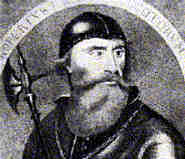Robert I of Scotland Bruce King of Scotland [8894] 24
- Born: 11 Jul 1274, Writtle, Chelmsford, Essex
- Marriage (1): Isobel of Mar [12461] in 1296
- Marriage (2): Elizabeth de Burgh [8893] in 1302
- Died: 7 Jun 1329, Cardoss Castle, Firth of Clyde, Scotland at age 54
- Buried: Dunfermline Abbey, Fife, Scotland

 General Notes: General Notes:
victor of Bannockburn 1314. Scotlands liberator & epic hero.
Assumed the Crown and Royal Dignity of Scotland, thus bringing to an end
the Second interregnum, in defiance of Edward I of England.
http://www.hull.ac.uk/php/cssbct/cgi-bin/gedlkup.php/n=royal?royal01447
Robert Bruce, the son of John Balliol's rival, had served Edward when he was young. Like his father, he had a claim to the throne, as did Balliol's nephew, Red John Comyn. These two men met at Greyfriars Kirk, in Dumfries, presumably to discuss plans for ridding their country of English domination. A quarrel arose between them and Bruce killed Comyn, in the kirk, thus committing sacrilege as well as murder. Excommunicated by Rome and hounded by the Comyns, he went to Scone crowned himself King of Scotland, in 1306.
Edward hurried north and defeated Bruce a month later. Outlawed, his friends and allies dead, Bruce went into hiding. During this time of in hiding, possibly on the island of Rathlin, off the Irish coast, he saw the legendary spider, whose determination and persistence finally enabled it to swing from one rafter to another on its web. If the spider could succeed, then so could he. Bruce returned to Scotland in 1307 on the death of Edward 1, overcame all other claimants to the throne and defeated Edward II at Bannockburn in 1314. Excommunicated by the Pope, Bruce's sovereignty was not recognized by Europe. In 1320 his Council met and decided to send a petition to the Pope, asking him to tell Edward to leave Scotland in peace, and to acknowledge Bruce as the rightful king. An elaborate Latin document was drafted, and signed by eight earls and 38 barons. This Declaration of Independence was a passionate plea for freedom from English harassment emphasizing the ancient Celtic line of the Scots and playing down the Anglo-Norman blood that had infiltrated their veins. It states 'as long as but a hundred of us remain alive, never will we on any conditions be brought under English rule.' The Pope was sufficiently impressed by the appeal and advised Edward to leave Scotland. Edward was not so easily deterred. He marched his army across the Tweed but Bruce’s army so devastated the land that the English army died of famine and dysentery. They fled back to England, sacking and desecrating abbeys, killing priests and monks. The Pope finally acknowledged Bruce's claim to the Scottish throne and he reigned a further 15 years.
http://www.goscotland.info/sections/?Section_Id=4&Page_Id=20

 Noted events in his life were: Noted events in his life were:
• Acceded, 27 Mar 1306, Scone Abbey, Perthshire, England.

Robert married Isobel of Mar [12461] [MRIN: 5755], daughter of Donald of Mar 6th Earl of Mar [10518] and Helen [10523], in 1296. (Isobel of Mar [12461] died before 1302.)

Robert next married Elizabeth de Burgh [8893] [MRIN: 3719], daughter of Richard the Red Earl de Burgh 3rd Earl of Ulster [8890] and Margaret de Burgh [8891], in 1302. (Elizabeth de Burgh [8893] died on 26 Oct 1327 in Cullen Castle, Banffshire and was buried in Dunfermline Abbey, Fife, Scotland.)
|


 General Notes:
General Notes: